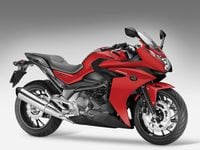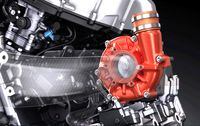It looks like Honda's economy-oriented laydown twin family, represented by the NC700X "adventure" bike and a pair of CTX700 standards (one naked; the other faired) look ready to be joined by a high(er)-performance supercharged flagship, if recent patent documents published in Japan can be trusted.
How does all of the new hardware fit? Say bye-bye to the huge luggage space (a.k.a., "frunk") under the dummy fuel tank of the NC700X—that's where the supercharger, intercooler, plenum, and all related plumbing now sits. The inclusion of an intercooler, which will boost performance and reliability by lowering the temperature of the intake air, is of particular interest here. Kawasaki's H2 superbike, which recently brought supercharging to the limelight, lacks an intercooler, suggesting just how challenging it is to add this technology to a bike with a more conventional engine layout.
The performance level of the new bike will depend hugely on boost levels, but the 670cc parallel twin, tilted forward at an angle of 62 degrees, makes in the neighborhood of just 50 hp and is so unstressed that even doubling the power is unlikely to strain it. Although 100 hp wouldn’t be earth shattering, it would be paired with huge torque for good all-around rideability and likely retain the NC’s inherent fuel economy. This new model might not shape up as a conventional superbike, but it could be a compelling option for someone seeking a sensible motorcycle that isn’t as personality-free as the current, naturally aspirated x700 line.
How it Works
The patents don't specify the type of supercharger used, but Honda will likely opt for a centrifugal design like that on the Kawasaki H2. Mounted above the engine, it will be driven off the crankshaft by gears, chain, or a belt, with gearing that massively increases its speed. Air will be sucked through a reinforced airbox—located between the rider's knees—and into the supercharger, where it will be compressed and sent to an air-to-air intercooler that's cooled by a ram-air system at the bike's nose. From there the intake charge goes to a plenum chamber—effectively a reserve of compressed air that stops surging as revs rise and fall—then on to the throttle bodies. A bypass valve on the plenum feeds any excess pressure back into the supercharger.
Why Supercharge?
Superchargers (and turbos too) are likely to become more common on bikes in the next few years, as toughening emissions regulations are pushing manufacturers to find new and ever-cleaner ways to build power. In cars, forced induction was once limited to high-performance machines, but now it's becoming common across all segments because it allows the use of smaller, more economical, and environmentally friendly engines without sacrificing peak power. Modern technology like direct fuel injection and advanced knock prevention also allows the use of much higher compression ratios than in the past, improving off-boost performance and reducing lag in power delivery.


/cloudfront-us-east-1.images.arcpublishing.com/octane/IN263JIBTBCD3O265IMSCW6OZM.jpg)
/cloudfront-us-east-1.images.arcpublishing.com/octane/SMAQ354X2JH7NJATXNSQY4NRS4.jpg)
/cloudfront-us-east-1.images.arcpublishing.com/octane/GGOH2AQRSVHY5C5JLNEVYLB5SU.jpg)
/cloudfront-us-east-1.images.arcpublishing.com/octane/TJJEHV3ATZFFXHUYZABHXKE2DI.jpg)
/cloudfront-us-east-1.images.arcpublishing.com/octane/WIC4RXQ36BAXNIW6U4UJ3XDLKI.jpg)
/cloudfront-us-east-1.images.arcpublishing.com/octane/B4PQZLY4LBHITGE5ZRRM2N5YNU.jpg)
/cloudfront-us-east-1.images.arcpublishing.com/octane/OBYS7KWZUJFCHD44YPTSVM5EF4.jpg)
/cloudfront-us-east-1.images.arcpublishing.com/octane/FY7ZXYBT4NH2NGYQIWQVITS4AM.jpg)
/cloudfront-us-east-1.images.arcpublishing.com/octane/JPET6WQUDZEYLNXVY5LRNDRPLA.jpg)
/cloudfront-us-east-1.images.arcpublishing.com/octane/EY6P2QIFQJCDTNOMR3JB7WJED4.jpg)
/cloudfront-us-east-1.images.arcpublishing.com/octane/V2U6JB7KXNCQRN4OW6HNJTVMZQ.jpg)
/cloudfront-us-east-1.images.arcpublishing.com/octane/AMS43BT5ABH77NY7XKLCSZCNM4.jpg)
/cloudfront-us-east-1.images.arcpublishing.com/octane/NTK2ASYKUBDW5MQDWQLVQYOELY.jpg)
/cloudfront-us-east-1.images.arcpublishing.com/octane/SX7R3KCIANGDBGF45O73F543TM.jpg)
/cloudfront-us-east-1.images.arcpublishing.com/octane/ZTW4V7RAPFG6RFWJRXR2IX5ZQ4.jpg)
/cloudfront-us-east-1.images.arcpublishing.com/octane/EPRSLPIUTBC5RPD7R263BPV2D4.jpg)
/cloudfront-us-east-1.images.arcpublishing.com/octane/EMJ4I2T4HVCRVJPZ3UJFVMRDHA.jpg)
/cloudfront-us-east-1.images.arcpublishing.com/octane/CBDAM3VMJNFDBLE7Y3FY7RD5BY.jpg)
/cloudfront-us-east-1.images.arcpublishing.com/octane/CCEB3TNMU5FH3OZ4FKJ7DA2LBA.jpg)
/cloudfront-us-east-1.images.arcpublishing.com/octane/VV6N3KUWEVFJJD7F7VX6ICOH7Q.jpg)
/cloudfront-us-east-1.images.arcpublishing.com/octane/R55SVEXZ5VA2LCWFWYR647ASX4.jpg)
/cloudfront-us-east-1.images.arcpublishing.com/octane/MYWIEFOQ6JCCNDR4OBF5PU5LVE.jpg)
/cloudfront-us-east-1.images.arcpublishing.com/octane/OOZ3C4GCUJGRNONDI6DHVM57GI.jpg)
/cloudfront-us-east-1.images.arcpublishing.com/octane/JEKB3CMWXZD6ZAVFEDKLOQ5FNY.jpg)